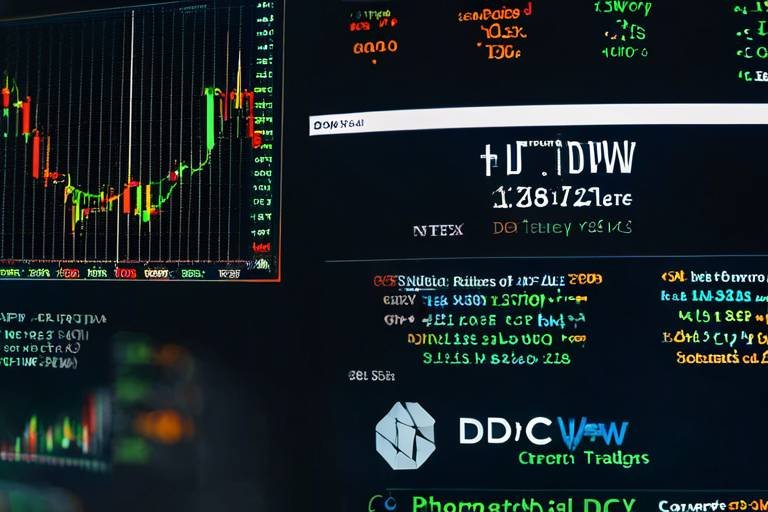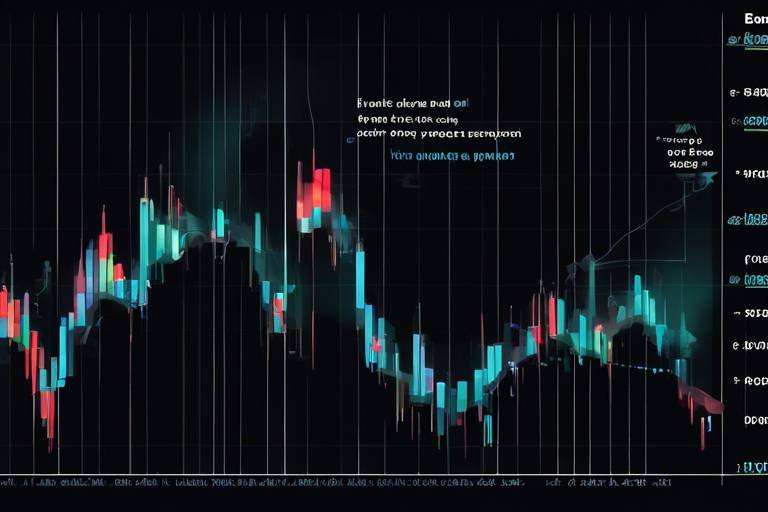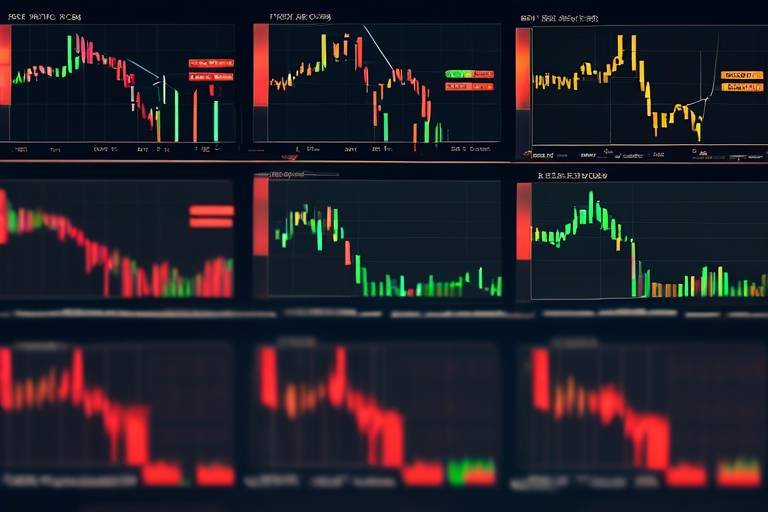How to Spot Market Trends Using Historical Data
In today's fast-paced financial world, understanding how to spot market trends using historical data is not just an advantage; it's a necessity. Imagine trying to navigate through a dense fog without a map—this is what investing can feel like without the insights that historical data provides. By analyzing past market behaviors, investors can uncover patterns that help predict future movements, making informed decisions that can lead to substantial gains.
Historical data serves as a foundation for analyzing market trends. It encompasses past prices, volumes, and other relevant metrics that help investors understand market behavior and predict future movements. Think of it as a treasure map of the financial landscape, where every data point is a clue leading you closer to potential profit. Without this data, investors are essentially flying blind, relying on gut feelings rather than concrete evidence.
When diving into historical data, it's crucial to recognize the different types available. Here are some key categories:
- Price Data: This includes historical prices of stocks, commodities, or currencies, providing insight into how these assets have performed over time.
- Volume Data: Understanding the volume of trades can reveal the strength of a trend, indicating whether a price movement is backed by solid investor interest.
- Economic Indicators: Metrics such as GDP growth, unemployment rates, and inflation can significantly impact market trends, offering context to price movements.
Each type of historical data offers unique insights into market dynamics and potential future trends, making it essential for investors to consider a comprehensive approach when analyzing the data.
Collecting historical data can be achieved through various methods, such as online databases, financial reports, and market analysis tools. The Internet has made this process easier than ever, with numerous platforms providing free or subscription-based access to historical data. Investors should consider the following methods:
- Online Databases: Websites like Yahoo Finance and Google Finance provide extensive historical data that can be easily accessed and analyzed.
- Financial Reports: Companies publish quarterly and annual reports that include historical performance data, which can be invaluable for trend analysis.
- Market Analysis Tools: Software like Bloomberg Terminal or TradingView offers sophisticated tools for collecting and analyzing historical data.
Understanding these methods is crucial for obtaining accurate and relevant data, as the quality of your analysis hinges on the data you collect.
Once you've collected your historical data, the next step is analysis. Several analytical tools can assist in evaluating historical data, including spreadsheets, statistical software, and specialized financial analysis platforms. For instance, using Excel can allow you to manipulate data easily, create charts, and perform calculations to identify trends. On the other hand, statistical software like R or Python can provide deeper insights through complex algorithms and models.
Recognizing market trends involves analyzing historical data for patterns and movements. Techniques such as moving averages and trend lines are essential for identifying whether a market is trending upward, downward, or sideways. For example, a simple moving average (SMA) can smooth out price data to highlight the direction of the trend. Similarly, drawing trend lines can help visualize the overall market direction, making it easier to spot potential reversals or continuations.
Real-world case studies illustrate how historical data analysis has successfully identified market trends. For instance, during the 2008 financial crisis, investors who analyzed historical data on housing prices were able to predict the downturn and adjust their portfolios accordingly. By examining past patterns, they could foresee the impending collapse of the housing market, reinforcing the importance of data-driven decision-making.
When analyzing historical data, investors may encounter common pitfalls, such as over-reliance on past performance or ignoring broader economic factors. It's easy to get caught up in the numbers and forget that markets are influenced by a myriad of factors, including geopolitical events, economic changes, and investor sentiment. Awareness of these pitfalls is essential for accurate analysis, as they can lead to misguided investment decisions.
Using historical data to spot trends also involves forecasting future market movements. This section explores methodologies for making predictions based on historical patterns and current market conditions. Techniques such as regression analysis and time series forecasting can be employed to project future trends. However, it’s vital to remain flexible and adapt to changing market conditions, as history doesn't always repeat itself perfectly.
- What is historical data? Historical data refers to past prices, volumes, and other metrics that provide insights into market behavior.
- How can I collect historical data? You can collect historical data through online databases, financial reports, and market analysis tools.
- What tools are best for analyzing historical data? Tools like spreadsheets, statistical software, and specialized financial platforms are effective for analyzing historical data.
- What are common pitfalls when analyzing historical data? Common pitfalls include over-reliance on past performance and ignoring broader economic factors.

Understanding Historical Data
When it comes to investing, is like having a treasure map that leads you to hidden gems in the market. This data serves as the backbone for analyzing market trends, offering insights into how prices and volumes have behaved over time. Think of it as the past performance of a stock or commodity, which can provide a glimpse into its potential future. By studying this data, investors can gain a clearer picture of market behavior, which is crucial for making informed decisions.
Historical data encompasses a variety of metrics, including past prices, trading volumes, and even economic indicators. These metrics are vital because they help investors understand the factors that influence market movements. For instance, if a stock consistently rises after a particular earnings report, it may indicate a trend that could repeat in the future. The key is to analyze this data effectively to identify patterns and correlations.
Moreover, historical data isn't just a collection of numbers; it's a narrative of the market's journey. It tells the story of how external factors—like economic shifts, political events, or natural disasters—have impacted trading behavior. By piecing together these elements, investors can better predict how similar events might influence the market in the future.
To illustrate, let’s consider a few important types of historical data:
- Price Data: This includes historical prices of assets over specific time frames, allowing investors to see trends and fluctuations.
- Volume Data: Analyzing the volume of trades can reveal the strength of a price movement. High volume during a price increase often indicates strong market support.
- Economic Indicators: These include data like GDP growth rates, unemployment rates, and inflation, which can provide context for market movements.
Understanding these types of data is essential for any investor looking to navigate the complexities of the market. It's not just about looking at numbers; it's about interpreting them in a way that makes sense in the broader context of market dynamics. As you dive deeper into historical data, you'll find that it can reveal more than just trends—it can uncover opportunities and risks that might not be immediately apparent.
In conclusion, the ability to analyze historical data effectively can set you apart in the world of investing. It’s like having a sixth sense that guides your decisions based on past experiences. By leveraging this data, you can enhance your investment strategy, reduce risks, and potentially boost your returns.

Types of Historical Data
When diving into the world of market trends, it's crucial to understand that not all historical data is created equal. Different types of historical data can provide unique insights that are essential for anyone looking to make informed investment decisions. The three primary types of historical data that investors often rely upon are price data, volume data, and economic indicators. Each serves a distinct purpose and can illuminate different aspects of market behavior.
Price data is perhaps the most straightforward type of historical data. It refers to the historical prices of a security or asset over time. By examining price trends, investors can identify patterns such as support and resistance levels, which are critical for making buying or selling decisions. For instance, if a stock has consistently bounced back from a certain price level, that level may be considered a support level. Conversely, if it has faced resistance at a specific price point, that could indicate a potential barrier to future price increases.
Next up is volume data, which tracks the number of shares traded during a specific timeframe. Volume can be a powerful indicator of market strength. For example, a price increase accompanied by high volume suggests strong investor interest and confidence, while a price increase on low volume may indicate a lack of conviction. Understanding volume can help investors gauge whether a trend is likely to continue or reverse. It’s like being at a concert; if the crowd is roaring, you know the band is doing something right!
Lastly, we have economic indicators, which are statistics that reflect the overall health of the economy and can impact market trends. These indicators include metrics like GDP growth, unemployment rates, and inflation. By analyzing these indicators alongside historical price and volume data, investors can gain a broader perspective on market dynamics. For example, if economic indicators suggest a recession is looming, even a stock with strong price performance might not be a safe bet.
To summarize, understanding these types of historical data is essential for anyone serious about spotting market trends. By combining insights from price data, volume data, and economic indicators, investors can create a comprehensive picture that enhances their decision-making process. It's like having a toolbox; each type of data is a different tool that can help you build a better strategy. So, the next time you analyze market trends, remember to consider all these aspects to ensure you're not missing out on critical information!
| Type of Historical Data | Description | Key Insights |
|---|---|---|
| Price Data | Historical prices of securities or assets over time | Identifies support and resistance levels |
| Volume Data | Tracks the number of shares traded in a given timeframe | Indicates market strength and investor confidence |
| Economic Indicators | Statistics reflecting the overall health of the economy | Provides context for market trends and potential risks |

Data Collection Methods
When it comes to spotting market trends, the first step is gathering the right historical data. Think of this as laying the groundwork for a sturdy house; without a solid foundation, everything else can crumble. There are various methods to collect historical data, and each has its own strengths and weaknesses. Understanding these methods is crucial for obtaining accurate and relevant information that can guide your investment decisions.
One of the most common methods for collecting historical data is through online databases. Websites like Yahoo Finance, Google Finance, and Bloomberg offer extensive archives of price data, trading volumes, and other essential metrics. These platforms are user-friendly and often allow you to download data in various formats, making it easy to analyze. However, while these sources are invaluable, it's essential to verify the accuracy of the data, as discrepancies can lead to misguided decisions.
Another effective way to gather historical data is through financial reports. Companies are required to publish quarterly and annual reports, which contain a wealth of information about their financial health, including revenue, expenses, and cash flow. These reports can provide insights into how a company has performed over time, helping you to gauge its future potential. However, analyzing financial reports requires a bit of expertise, as you need to understand how to interpret the data correctly.
Additionally, market analysis tools can be a game-changer in your data collection efforts. Tools like TradingView and MetaTrader offer advanced features that allow you to visualize data trends through charts and graphs. These platforms often come with built-in indicators that can help you identify patterns that may not be immediately obvious. While these tools can be incredibly helpful, they may also come with a learning curve, so it's worth investing some time to familiarize yourself with their functionalities.
In summary, effective data collection methods include:
- Online Databases: Easy access to historical price and volume data.
- Financial Reports: In-depth insights into a company's financial performance.
- Market Analysis Tools: Advanced visualization and analytical capabilities.
Remember, the method you choose depends on your specific needs and the type of data you are looking to analyze. By employing a combination of these methods, you can ensure that you have a comprehensive view of market trends, which will ultimately empower you to make more informed investment decisions.
Q: What is the best source for historical market data?
A: The best source often depends on your specific needs, but online databases like Yahoo Finance and Bloomberg are widely regarded as reliable options.
Q: How can I ensure the accuracy of the data I collect?
A: Always cross-reference data from multiple sources and look for reputable platforms that have a history of providing accurate information.
Q: Are market analysis tools necessary for data collection?
A: While not strictly necessary, market analysis tools can significantly enhance your ability to visualize and interpret data, making them a valuable addition to your toolkit.

Tools for Analyzing Historical Data
When it comes to analyzing historical data, having the right tools at your disposal can make all the difference. Think of these tools as your trusty toolbox, each one designed to help you tackle different aspects of data analysis. Whether you're a seasoned investor or just dipping your toes into the world of market trends, understanding how to leverage these tools is vital for making informed decisions.
First off, let’s talk about spreadsheets. Programs like Microsoft Excel or Google Sheets are incredibly versatile and user-friendly. They allow you to organize large sets of data, perform calculations, and create visualizations like graphs and charts. Imagine you're trying to track stock prices over the past five years. With a spreadsheet, you can easily input your data and use functions to calculate averages, growth rates, or even forecast future prices based on historical trends. The beauty of spreadsheets lies in their flexibility; you can customize them to suit your specific analysis needs.
Next up are statistical software packages such as R or Python. These tools take your analysis to the next level by allowing you to perform complex statistical tests and create sophisticated models. If spreadsheets are your basic tools, think of statistical software as your power tools. They can handle large datasets and perform operations that would be cumbersome, if not impossible, in a standard spreadsheet. For instance, you can use R to run regression analyses, which can help you understand the relationships between different market factors. This level of analysis can uncover trends that you might not see with simpler tools.
Another category of tools worth mentioning is specialized financial analysis platforms. Platforms like Bloomberg Terminal or Morningstar Direct provide comprehensive data and analytics tailored specifically for financial markets. These platforms often come with built-in tools for tracking historical data, analyzing trends, and even comparing different investment options. Imagine having a personal analyst by your side, sifting through mountains of data to provide you with actionable insights. That’s what these platforms do, and they’re invaluable for serious investors looking to make data-driven decisions.
To make the most of these tools, you should also consider integrating them. For example, you can export data from a financial platform into a spreadsheet for further analysis or visualization. This multi-tool approach allows you to combine the strengths of each tool, ensuring that you have a comprehensive view of the market. Just as a chef uses various utensils to create a delicious dish, you too can mix and match these tools to whip up insightful analyses that can inform your investment strategies.
Ultimately, the key to successfully analyzing historical data lies in understanding the strengths and limitations of each tool. By choosing the right tools for your specific needs, you can gain deeper insights into market trends and make more informed investment decisions. So, whether you’re crunching numbers in a spreadsheet or running complex models in statistical software, remember that the right tools are your best allies in the quest for market understanding.
- What is the best tool for beginners? For beginners, spreadsheets like Microsoft Excel or Google Sheets are highly recommended due to their user-friendly interface and wide range of functionalities.
- Can I analyze historical data without specialized software? Yes, while specialized software offers advanced features, you can perform basic analysis using spreadsheets or even free online tools.
- How do I choose the right tool for my needs? Consider your specific analysis goals, the complexity of the data, and your comfort level with technology when choosing a tool.

Identifying Market Trends
Identifying market trends is like being a detective in the world of finance. You sift through clues—data points, price movements, and volume fluctuations—to uncover the story of what the market is doing. It’s not just about looking at numbers; it’s about understanding the psychology behind those numbers. Are investors feeling optimistic? Are they worried? These emotional undercurrents can significantly influence market behavior.
One effective way to identify trends is through the use of moving averages. This technique smooths out price data by creating a constantly updated average price, allowing you to see the direction in which the market is heading without the noise of daily fluctuations. For instance, a 50-day moving average can help you determine the short-term trend, while a 200-day moving average provides insights into long-term trends. When the short-term average crosses above the long-term average, it may signal a bullish trend, while the opposite could indicate a bearish trend.
Another important tool is the trend line. Drawing a trend line involves connecting the lows in an uptrend or the highs in a downtrend, providing a visual representation of the market's direction. This method allows you to quickly gauge whether the market is moving upward, downward, or sideways. By observing how prices react to these lines, you can gain insights into potential reversals or continuations of trends.
Additionally, it's crucial to consider the volume accompanying price movements. Volume is a powerful indicator of the strength of a trend. For example, if a stock's price rises significantly but the volume is low, it may suggest a lack of conviction among buyers, making the trend less reliable. Conversely, a price increase supported by high volume can indicate strong buying interest, reinforcing the trend’s validity.
| Trend Type | Description | Indicators |
|---|---|---|
| Uptrend | Prices consistently rise, creating higher highs and higher lows. | Moving Averages, Trend Lines, Volume Increases |
| Downtrend | Prices consistently fall, forming lower highs and lower lows. | Moving Averages, Trend Lines, Volume Decreases |
| Sideways Trend | Prices move within a horizontal range, lacking a clear direction. | Support and Resistance Levels, Low Volume |
Finally, remember that market trends are not set in stone. They can change rapidly due to various factors, including economic news, earnings reports, or geopolitical events. Therefore, it’s essential to stay informed and be ready to adapt your strategies. By continuously analyzing historical data and applying these techniques, you can enhance your ability to identify market trends effectively.
- What is a market trend? A market trend refers to the general direction in which the price of a security or market is moving, which can be upward, downward, or sideways.
- How can I identify a trend? You can identify trends through tools like moving averages, trend lines, and by analyzing volume data.
- Why is volume important in trend analysis? Volume indicates the strength of a price movement. High volume during a price increase suggests strong buying interest, while low volume may indicate weak support for the trend.

Case Studies and Examples
To truly grasp the power of historical data in identifying market trends, let’s dive into some compelling case studies that showcase this principle in action. One notable example is the analysis of the 2008 financial crisis. By examining historical price data and economic indicators leading up to the crash, analysts were able to identify patterns of overvaluation in the housing market. This analysis, which included a review of mortgage-backed securities and their performance over time, revealed a troubling trend: a significant increase in housing prices that was not supported by underlying economic fundamentals. Investors who relied on this historical data were able to mitigate their losses or even profit by shorting the housing market before the crash occurred.
Another fascinating case study involves the tech boom of the late 1990s. By analyzing historical volume data and stock prices of tech companies, investors could observe a rapid increase in market participation and speculative trading. This data indicated a trend where many investors were buying into companies based solely on hype rather than solid financial performance. Those who paid attention to these historical trends could foresee the impending correction and avoid the drastic losses that followed. The lesson here is clear: understanding past behaviors can provide invaluable insights into future market movements.
Additionally, let’s consider the rise and fall of cryptocurrencies. The historical data surrounding Bitcoin, for instance, shows a pattern of rapid price increases followed by sharp corrections. By utilizing moving averages and trend lines, investors could identify key support and resistance levels. For example, in early 2021, when Bitcoin's price surged past $40,000, historical data indicated that similar surges in the past were often followed by corrections. Those who analyzed this data were better prepared for the volatility that ensued.
These case studies not only highlight the importance of analyzing historical data but also emphasize the necessity of employing various analytical techniques. By combining different types of historical data, such as price movements, trading volumes, and economic indicators, investors can create a more comprehensive view of market dynamics. It’s not just about looking at numbers; it’s about understanding the story they tell.
In conclusion, the power of historical data cannot be overstated. The examples of the 2008 financial crisis, the tech boom, and the cryptocurrency market illustrate how thorough analysis can lead to informed decision-making. Investors who embrace a data-driven approach, leveraging historical trends and patterns, are often the ones who navigate market fluctuations with greater success.
- What is historical data? Historical data refers to past prices, volumes, and other relevant metrics that help analyze market behavior.
- How can I collect historical data? You can collect historical data through online databases, financial reports, and market analysis tools.
- What tools are best for analyzing historical data? Tools like spreadsheets, statistical software, and specialized financial analysis platforms are effective for evaluating historical data.
- Why is it important to identify market trends? Identifying market trends helps investors make informed decisions and anticipate future price movements.

Common Pitfalls to Avoid
When it comes to analyzing historical data for market trends, even seasoned investors can stumble into common traps that may skew their analysis. One of the most significant pitfalls is the tendency to over-rely on past performance. While historical data provides valuable insights, it’s crucial to remember that past results do not guarantee future outcomes. Markets are influenced by a myriad of factors, including economic shifts, geopolitical events, and changes in consumer behavior. Therefore, basing decisions solely on historical data can lead to misguided investments.
Another frequent mistake is ignoring broader economic factors. For instance, while a stock may have shown consistent growth in the past, external elements like a recession or changes in legislation can dramatically alter its trajectory. It’s essential to contextualize historical data within the current economic landscape. This means considering indicators such as GDP growth rates, unemployment figures, and inflation trends, which can all impact market behavior.
Additionally, many investors fall into the trap of confirmation bias. This occurs when individuals seek out data that supports their existing beliefs while disregarding information that contradicts them. This selective analysis can lead to skewed interpretations of historical data, resulting in poor investment decisions. To combat this, it’s vital to approach data analysis with an open mind, actively seeking out diverse perspectives and alternative viewpoints.
Moreover, neglecting to account for volatility in historical data can be detrimental. Markets can be unpredictable, and trends can shift rapidly. An investor who fails to recognize this volatility may misinterpret a short-term trend as a long-term pattern. To mitigate this risk, it’s advisable to employ statistical measures that account for volatility, such as standard deviation and beta coefficients, to provide a clearer picture of market behavior.
Lastly, many investors underestimate the importance of data quality. Poor-quality data can lead to erroneous conclusions. Always ensure that the sources of your historical data are credible and up-to-date. Utilizing reliable databases and financial reports can make a significant difference in the accuracy of your analysis.
In summary, avoiding these common pitfalls is crucial for effective historical data analysis. By being mindful of over-reliance on past performance, considering broader economic factors, combating confirmation bias, accounting for volatility, and ensuring data quality, investors can enhance their ability to identify genuine market trends and make informed decisions.
- What is the most common mistake investors make when analyzing historical data? Over-relying on past performance without considering current market conditions is a frequent error.
- How can I avoid confirmation bias in my analysis? Approach data with an open mind and actively seek out diverse perspectives and conflicting information.
- Why is data quality important in historical analysis? Poor-quality data can lead to incorrect conclusions, impacting investment decisions negatively.
- What tools can help analyze historical data effectively? Tools like spreadsheets, statistical software, and specialized financial analysis platforms can aid in evaluating historical data.

Future Trends and Predictions
When it comes to predicting future market trends, the past is not just a chapter in a book; it's the entire library! Historical data provides us with a wealth of information that can help investors forecast what might happen next. By analyzing patterns and movements from previous market behavior, we can make educated guesses about future directions. This isn't just guesswork; it's a science that combines data analysis with a touch of intuition.
One of the most effective methodologies for making these predictions is through the use of statistical models. These models can range from simple linear regressions to more complex machine learning algorithms. Each model offers a unique lens through which to view the data, allowing investors to uncover insights that might not be immediately obvious. For instance, a simple moving average can smooth out price fluctuations, helping to highlight longer-term trends. On the other hand, more sophisticated models can account for variables like economic indicators and market sentiment, offering a more comprehensive view.
Another key aspect of forecasting future trends involves understanding the broader economic landscape. It's essential to consider factors such as interest rates, inflation, and geopolitical events. These elements can have a profound impact on market dynamics and should not be overlooked. For example, if inflation rates are rising, consumer spending may decline, leading to a potential downturn in certain sectors. Thus, integrating economic indicators into your analysis can enhance the accuracy of your predictions.
Moreover, technology has revolutionized the way we analyze historical data and make predictions. With the rise of big data and advanced analytics, investors now have access to an unprecedented amount of information. Tools like predictive analytics software can process vast datasets in real-time, identifying trends faster than ever before. This means that investors can act swiftly, capitalizing on opportunities before they vanish. Imagine having a crystal ball that not only shows you the future but also allows you to react in the moment—this is the power of modern data analytics!
As we look ahead, it’s crucial to remain adaptable. The market is constantly evolving, influenced by a myriad of factors. Therefore, while historical data can provide a solid foundation for predictions, it’s important to remain vigilant and ready to adjust our strategies as new information comes to light. Remember, predicting the future is more of an art than a science; it requires a blend of data analysis, intuition, and a willingness to embrace change.
In conclusion, the journey of forecasting future market trends is one filled with excitement and uncertainty. By leveraging historical data, utilizing advanced analytical tools, and staying informed about economic conditions, investors can significantly enhance their chances of making successful predictions. So, as you navigate the intricate world of investing, remember that the past holds the keys to unlocking future opportunities!
- How reliable are predictions based on historical data?
While historical data can provide valuable insights, it's important to remember that markets are influenced by many variables. Predictions are not guarantees, but informed estimates.
- What tools can I use for analyzing historical data?
There are several tools available, including spreadsheets, statistical software, and specialized financial analysis platforms. Each tool has its own strengths and can be used depending on your specific needs.
- Can I rely solely on historical data for investment decisions?
No, it's crucial to consider current market conditions and broader economic factors. Historical data should be one component of a comprehensive analysis strategy.
Frequently Asked Questions
- What is historical data and why is it important for market analysis?
Historical data refers to past market information, including prices and volumes, that helps investors understand how the market has behaved over time. By analyzing this data, traders can spot patterns and trends that may indicate future movements, making it a vital tool for informed investment decisions.
- What types of historical data should I focus on?
When analyzing market trends, it’s essential to consider various types of historical data, such as price data, volume data, and economic indicators. Each type provides unique insights, allowing you to paint a clearer picture of market dynamics and potential future trends.
- How can I collect historical data effectively?
There are several methods to collect historical data, including online databases, financial reports, and using market analysis tools. Choosing the right method depends on your specific needs and the accuracy of the data you want to obtain.
- What tools are available for analyzing historical data?
Investors can utilize various analytical tools for evaluating historical data, such as spreadsheets, statistical software, and specialized financial analysis platforms. These tools help identify patterns and trends, enabling better decision-making.
- What techniques can I use to identify market trends?
To spot market trends, you can use techniques like moving averages and trend lines. These methods help you analyze historical data to determine whether the market is trending upwards, downwards, or moving sideways.
- Can you provide examples of successful historical data analysis?
Absolutely! Real-world case studies demonstrate how various investors have successfully used historical data analysis to identify market trends. These examples highlight the importance of data-driven decision-making in achieving investment success.
- What common pitfalls should I avoid when analyzing historical data?
Some common pitfalls include over-relying on past performance and ignoring broader economic factors. Being aware of these pitfalls is crucial for ensuring your analysis remains accurate and relevant.
- How can historical data help predict future market trends?
Historical data can be used to forecast future market movements by identifying patterns and analyzing current market conditions. By understanding these trends, you can make more informed predictions about where the market might head next.



















